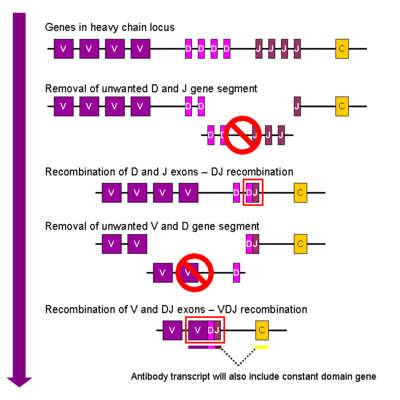V (D) J recombination
The V (D) J recombination (also known as somatic recombination referred to) is a genetic rearrangement process on the DNA of vertebrates , of the variability of the B-cells produced antibodies (also called immunoglobulins), the B-cell receptors , as well as the T-cell receptors . It plays a crucial role in the adaptive immune system by enabling the detection of a large number of antigens of bacterial , viral or parasitic origin.
It is worth mentioning that this is one of the few known processes in which the genetic information ( DNA ) in somatic, proliferating cells is systematically, so to speak 'intentionally' changed.
function
During the development of a B-cell, the genes for the light and heavy chains of the antibodies and T-cell receptors are combined and recombined as random selections from different DNA sections available .
The variable components of both chains (V regions) are made up of different sections. These are the V-segments and J-segments in the case of the light chains and in addition to these two the D-segments in the case of the heavy chains. There are several variants of each segment in the genome, one of which can be found in the finished gene. This recombination only happens once per cell and it is left to chance which allele, ie which gene on homologous chromosomes (from mother or father), is recombined first. If successful (see below), the recombination of one allele inhibits the processing of the second allele ("allele exclusion").
Additional variability arises as a junctional diversification , because the interfaces are not precisely specified when cutting and joining and also random nucleotides can be incorporated. In addition, various light and heavy chains can be combined with one another. Ultimately (excluding junctional diversification and somatic hypermutation ) there are approximately 1.92 million possible combinations for the formation of immunoglobulins.
Genetic background
Products produced by a B cell immunoglobulins consist fundamentally of two identical long ( heavy , engl .: heavy) H-chains and two identical short ( light , engl .: light) L-chains (κ- or λ chain). These chains each have a constant (C-) and a variable (V (D) J-) part.
| Chain | Locate | Domains |
|---|---|---|
| h chain | Chromosome 14 | V H , D H , J H |
| κ chain | Chromosome 2 | V L , J L |
| λ chain | Chromosome 22 | V L , J L |
The κ and λ locus differ in the arrangement of the V, J and C segments: while the V and J segments are in clusters in the κ locus (there is only one C segment), they are in the λ -Locus four JC pairs. The organization of the heavy chain locus corresponds to the κ locus, but contains several C segments and a D cluster between the V and J clusters. In all cases, each V-segment is preceded by an L-segment (leader), which represents the signal sequence for the translocation into the rough endoplasmic reticulum .
The T cell receptor consists of α and β chains, the former being similar to the immunoglobulin light chain and the latter being a fragment (the Fab fragment ) of the heavy chain.
| Chain | Locate | Domains |
|---|---|---|
| α chain | Chromosome 14 | V α , J α |
| β chain | Chromosome 7 | V β , D β , J β |
The locus refers to humans.
The name V (D) J recombination is derived from the English name for the individual recombined gene segments (V - variable; D - diversifying; J - joining). In addition, there is always a C area (C - constant). The variable area is decisive for antigen recognition, while the constant area defines the five immunoglobulin classes or is responsible for membrane anchoring in the case of the T cell receptor .
The large repertoire of immunoglobulins and T-cell receptor specificities, which would exceed the size of the genome if there were a separate gene for each molecule , is realized, among other things, by the fact that the individual gene segments (V, D, J) are present the rearrangement are available in several copies, which can be combined with one another as required in the manner of a combination lock during the maturation of the lymphocytes.
| segment | H chain | κ and λ chains | α chain | β chain |
|---|---|---|---|---|
| V | 40 | 40/30 | ≈ 70 | 52 |
| D. | 25th | - | - | 2 |
| J | 6th | 5/4 | 61 | 13 |
There are also a number of pseudogenes that are available for rearrangement, but cannot form a functional chain.
procedure
Immunoglobulins
When the heavy chain is rearranged, a D and a J segment are first linked before they are added to a V segment and form a common exon with this. In the case of the light chain (without a D segment), the V and J segments can be connected immediately. The V region generated in this way is separated from the C region by an intron, so the merging takes place after transcription by splicing .
The recombination status is a criterion for determining the stage of B-cell maturation .
See also
literature
- Murphy, Travers, Walport: Janeway's Immunobiology . 7th edition. Garland Science, New York, Abingdon 2007, ISBN 0-8153-4123-7 .
- Raul Mostoslavsky et al., The Lingering Enigma of the Allelic Exclusion Mechanism (Review) , In: Cell , Vol. 118, 539-544, 2004
